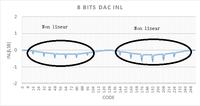ansonyeap
Member level 2
Dear all,
I have designed a 8 bits DAC with folded R-string structure.
however, I notice that the output INL linearity degraded as shown in the picture below:

I check one of the settling time of the code transition i.e from Code0 to Code32, the output settling time is more than 0.5us.
Currently I am using the same size transmission gate as the switches to select the output.
My DAC output is driving a capacitor load of 10pF.
Is there anyway to further improve the settling time to around less then 0.2us? as my DAC have to work at speed more than 4MHz.
thank you
I have designed a 8 bits DAC with folded R-string structure.
however, I notice that the output INL linearity degraded as shown in the picture below:

I check one of the settling time of the code transition i.e from Code0 to Code32, the output settling time is more than 0.5us.
Currently I am using the same size transmission gate as the switches to select the output.
My DAC output is driving a capacitor load of 10pF.
Is there anyway to further improve the settling time to around less then 0.2us? as my DAC have to work at speed more than 4MHz.
thank you